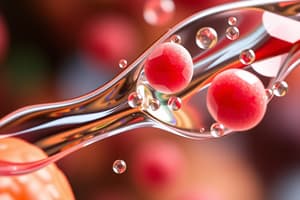Podcast
Questions and Answers
What is the definition of diffusion?
What is the definition of diffusion?
- Diffusion that requires energy
- The process of separating particles
- The movement of water across a membrane
- The movement of particles from regions of higher density to regions of lower density (correct)
What is osmosis?
What is osmosis?
The diffusion of water across a selectively permeable membrane
What is simple diffusion?
What is simple diffusion?
Diffusion that doesn't involve a direct input of energy or assistance by carrier proteins
What is facilitated diffusion?
What is facilitated diffusion?
What is active transport?
What is active transport?
What is a concentration gradient?
What is a concentration gradient?
Hydrophobic means water loving.
Hydrophobic means water loving.
Hydrophilic means water loving.
Hydrophilic means water loving.
What does hypertonic mean?
What does hypertonic mean?
What does hypotonic mean?
What does hypotonic mean?
What does isotonic mean?
What does isotonic mean?
What is a protein pore?
What is a protein pore?
What are hydrophilic heads?
What are hydrophilic heads?
What are hydrophobic tails?
What are hydrophobic tails?
What is ATP?
What is ATP?
What is the cell membrane?
What is the cell membrane?
Flashcards are hidden until you start studying
Study Notes
Diffusion Concepts
- Diffusion: Movement of particles from areas of high density to low density, driving the distribution of substances.
- Osmosis: A specific type of diffusion focused on water movement across a selectively permeable membrane, affecting cell volume.
- Simple Diffusion: Characterized by no energy input or carrier proteins, allowing small nonpolar molecules to pass through membranes easily.
Transport Mechanisms
- Facilitated Diffusion: Involves specific proteins that create channels in the cell membrane for certain molecules, enabling their movement without energy.
- Active Transport: Contrasts passive processes by utilizing ATP to move substances against their concentration gradient, crucial for nutrient uptake.
Concentration and Solutions
- Concentration Gradient: The difference in concentration of a substance between two locations, influencing movement direction during diffusion.
- Hypertonic Solutions: Have a higher solute concentration compared to another solution, leading to water movement out of cells.
- Hypotonic Solutions: Feature a lower solute concentration, potentially causing cells to swell as water flows in.
- Isotonic Solutions: Maintain equal solute concentration compared to another solution, resulting in no net movement of water.
Membrane Structure
- Protein Pore: Specialized channels that permit larger molecules to traverse the cell membrane, essential for cellular function.
- Hydrophilic Head: Refers to the water-attracting aspect of phospholipids in the cell membrane, facilitating interactions with the aqueous environment.
- Hydrophobic Tail: Describes the water-repelling portion of phospholipids, forming a barrier important for membrane integrity.
Energy and Membrane Function
- ATP (Adenosine Triphosphate): The energy currency required for active transport processes, enabling cells to maintain homeostasis.
- Cell Membrane: A selectively permeable barrier regulating which molecules enter or exit a cell, crucial for maintaining cellular function and environment.
Studying That Suits You
Use AI to generate personalized quizzes and flashcards to suit your learning preferences.




